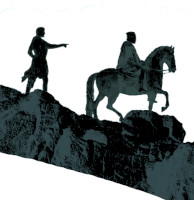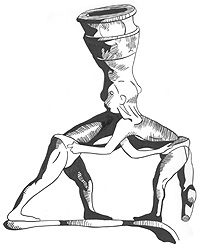Claudius, who had come to power at age 54, had named Aurelain, a war-like peasant’s son who was known to have slain 48 Sarmations with his own hand, and in total slew 950 enemies over his heroic life. Valerian had named him “The Rival of the Scythians.” He would reign as a brilliant warrior and civil engineer, recovering all provinces from revolts and invasions, and even improving infrastruture, demanding that weapons, clothing and horses be maintained, that all booty should be had from barbarian enemies, “Their wealth should be collected from the spoil of the enemy not from the tears of the provincials.”
Aurelian’s punishments for crimes were terrible, like being torn between trees, for instance.
“New multitudes” poured out of the Ukraine, and fought such a desperate draw, that Aurelian made piece with them and established a feudal treaty, with the Goths sending their young men into Roman service. This hints at a great menace out of the Hinterland, perhaps a climate crisis and or, perhaps the first Asiatic nomads to threaten the Caspian and Euxine watersheds. At the very least, it seems that the Scythians and Sarmations had lost their homeland in the far Siberian Mountains, which an ancient king had boasted to Darius he would fight to defend. [1]
The newly settled semi-barbarian Gothic, Sarmation, Vandal colony of Dacia [which Trajan had exterminated of its original civilized inhabitants] was established as a buffer region. Gibbon suggests that Trajan had fatefully over extended the empire with this conquest.
Then the Alimani, the alliance of horse bands and running foot men, emerged from the north forest and raided Italy. These were ambushed by Aurelian, who waited for them on the north bank of the Danube and used Hannibal’s double envelopment tactic. “A long line of the masters of the world,” presented these barbarians with an awful conqueror who sat in a throne. The barbarian ambassadors asked for too much money from the emperor, and were about to be starved out. They broke out back to the south and the Alps.
The barbarians marched “with the design of frighting the mistress of the world,” Three battles in northern Italy occurred, the first a bloody draw, the second [2], the decisive battle of Farni, outside of Rome, which the Alimani agreed was won by the Romans with the aid of a spectral army, which might have inspired Tolkien and his ghost army coming to the aid of Minis Tirith. This “defense of the capital betrayed the weakness of the monarchy.”
A queen “Augusta, Mother of the Camps” reigned over Gaul for a time, murdered by her military governor Tetrichus, who defected to Aurelian, whose army slaughtered the rebels.
Aurelian then turned on “the Chaste Virtue of Zenobia,” who was as beautiful as Cleopatra, dark complexioned, with pearly white teeth and large black eyes. She only had sex with her husband to bear children, never for the pleasure of submission. Her husband was a hero, who hunted lions, panthers and bears with her, the pair being a throwback to a proto-heroic age. [3] Zenobia and her husband, Odeanathis had worked as regents of Rome during the civil wars, but she refused to relinquish autonomy. Styling herself Queen of the East, this woman was doomed.
Appolonius of Tyranna, a contemporary of Jesus Christ, who in some accounts has been conflated as one in the same, was held sacred by Aurelian and the town of the Prophet’s birth was spared the rage of the legions. Two battles destroyed the armies of Zenobia, who were unarmored foot archers and armored horse archers. Palmyra, her oasis city, was declared by the beautiful widow of the hero to be her tomb.
What a woman, who tried to regain autonomy for her nation that had been subdued under Rome for 150 years. Her Arab allies harassed Aurelian’s army, this general emperor who wrote a letter to Rome admiring her high tech defense, which included fire belching war engines. He offered her life in defeat, and she insulted him, hoping that the Roman army would starve and the Persian King would come to her rescue. But that King Sapur, died at this time [4]. Zenobia escaped on a dromodary camel. But after some hundreds of miles, she was captured by Aurelian’s barbarian horsemen.
“When the Syrian Queen was brought into the presence of Aurelian,” she charmed him by naming him the only man that she could recognize as her conqueror. As the army clamored for her death, she begged her conqueror and blamed her male military advisor for misleading her, and she was apparently spared, as he and her people were slaughtered, including old men and women. Aurelian seemed to be ashamed of this atrocity. I would like to think that Zenobia served Aurelian in his bed.
He was then tasked with dethroning a wealthy merchant usurper in Egypt, so rich that he had glass windows, easily dispatched.
In a little more than three years, Aurelian restored “peace and power to The Roman World.”
1600 gladiators and animals from around the world were employed in his triumph, including goods and people from as far away as China. Among the many captives, were 10 “amazons” taken from thee Gothic nation, all displayed, including The Queen of the East, on parade. The vast numbers of people and animals brought to Rome in this triumph, does explain the increased spread of disease.
“The beauteous figure of Zenobia was displayed in fetters of gold.” She almost fainted under the weight of her jewels. She was given a villa and her daughters married Romans, with her blood line surviving hundreds of years and possibly including a Christian patriarch.
Aurelian worshipped The Sun, his mother having been a priestess of Apollo Helios, his patron deity.
“Surely the gods have decreed that my life will be one of continuous war,” as he commented on a slave rebellion that took the lives of 7,000 of his men. This revolt was of the slaves of the mint in Rome, who apparently rose up in the service of a plutocratic money master. The debasement of coinage could not be reversed and, as Gibbon notes, reformation occurs at a much slower rate than corruption.
“Rome, though deprived of freedom, was distracted by faction,” remarks Gibbon on the timeless facts of devolved urban powers.
Aurelian was a cruel man who could watch torture and executions without flinching. As a Plebian the Senate could not abide his rule, even though he was their savior. “He disdained to hold his power by any other right than that of the sword.” He was the right man to conquer, but not to rule. On the way to fight the Persians, Aurelian was murdered by his generals, who had been duped into reading a forged execution order, fabricated by Aurelian’s secretary, who the stern monarch had threatened. Aurelian was avenged by his army.
They declared it “the crime of one man and the error of man. This reader suspects a senatorial conspiracy, without supporting evidence.
Notes
-1. In a footnote, Gibbon states that the Wallachians, the folk of Vlad the Impaler, are ethnically distinct from the surrounding Slavic folk into his own age and have ever declared their Roman patrimony, marking them as an old Roman garrison cut off from Rome by the tumult of this age.
-2. “Fear is the parent of superstition,” declares Gibbon, and the people of Rome began addressing their old gods that had been neglected for Christian worship, for which the pious Aurelian chides them. This Rome had “long and beautiful suburbs.”
-3. I would judge that Zenobia and her king to be an inspiration for Howard’s King Conan and the Slave girl Zenobia who he took to wife, and also, and along with Bonnie and Clyde, the inspiration for Conan and Bilet in Queen of the Black Coast. She avenged the murder of her husband and ruled herself for five years.
-4. Another whisper of disease which among many incidental citations in this account.











